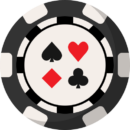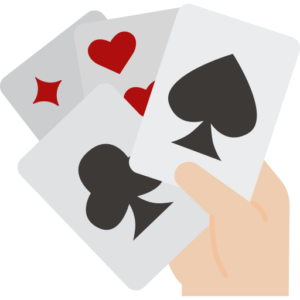Glossary Term
Open


Open
Used In: Poker
Introduction
In poker, “no limit” refers to a betting structure where players can wager any amount of their chips at any time during their turn. This contrasts with fixed-limit or pot-limit games, where the size of bets and raises is restricted. In no-limit games, a player can go “all-in” at any point, betting all their remaining chips in a single move, making for a highly strategic and high-stakes environment.
The most well-known variant of no-limit poker is No-Limit Texas Hold'em, which is the standard format for major tournaments like the World Series of Poker. The no-limit structure adds psychological pressure and emphasizes player skill, as it forces opponents to make difficult decisions with incomplete information. Bluffing, reading opponents, and managing stack sizes are crucial elements of successful play in this format.
Because of its open-ended betting, no-limit poker offers both high rewards and high risks. A single hand can dramatically change the outcome of a session or tournament. This format attracts competitive players who thrive on bold moves and sharp strategy, and it’s a major reason why poker has grown into a global spectator sport.
In Depth Look
In poker, “no limit” is a betting structure that allows a player to bet any amount of their chips at any point during their turn. Unlike fixed-limit or pot-limit games, where the size of bets is controlled, no-limit games remove these restrictions entirely. This creates a dynamic environment where strategy, psychology, and risk tolerance play central roles. The flexibility of betting in no-limit poker means that a single decision can result in winning or losing an entire stack, making each move potentially game-changing.
No-Limit Texas Hold’em is the most popular no-limit variant, especially in tournament settings. Its appeal lies in the depth of decision-making it allows. Players must carefully manage their chip stacks, assess opponent behavior, and determine the optimal time to commit large amounts of chips. Because the potential bet sizes are unlimited, opponents can be forced to make difficult calls for their entire tournament life, amplifying the pressure and drama of the game.
Key features of no-limit poker include:
- Unlimited bet sizing: Players can bet any amount up to their total chip stack, giving them full control over pressure and pot manipulation.
- High variance and psychological depth: With the constant threat of an all-in, decisions often rely on reading opponents and evaluating risk under pressure.
- Stack-size strategy: The relative size of each player’s stack significantly affects betting choices and hand selection, especially in tournament play.
Mechanics
In poker, the term “open” refers to the first voluntary bet made in a betting round. This action comes after any mandatory bets, such as blinds or antes, and initiates the competitive part of the hand. The player who opens the betting sets the tone for the round, establishing the minimum amount that other players must at least call to continue.
The mechanics of opening depend on the game type and position. In games like Texas Hold’em, the first opportunity to open occurs to the left of the big blind. The player in that position can choose to fold, call the big blind, or raise—this first raise is considered the “open.” If all players before a certain seat have folded, and that player chooses to bet more than the minimum required, they are said to be opening the pot.
Opening has strategic implications. It signals strength or aggression and can influence how other players respond. A well-timed open can steal blinds, isolate weaker opponents, or build a pot with a strong hand. Position, table dynamics, and chip stacks all play into when and how players choose to open.


Illustrated Example
Imagine a game of No-Limit Texas Hold’em with six players at the table. The small blind is $1, and the big blind is $2. After the blinds are posted, the first player to act is seated directly to the left of the big blind—this position is called Under the Gun (UTG). If the UTG player decides to raise to $6, this action is called an open because it is the first voluntary bet of the hand. All other players must now decide whether to call the $6, raise further, or fold.
Here’s a table showing how the action unfolds after the UTG player opens to $6:
| Seat | Action | Explanation |
|---|---|---|
| Small Blind | Posts $1 | Mandatory blind; acts after other players |
| Big Blind | Posts $2 | Mandatory blind; may defend if no raise |
| UTG | Raises to $6 | First voluntary bet—this is the open |
| Hijack | Folds | Chooses not to continue |
| Cutoff | Calls $6 | Matches the open bet |
| Button | Raises to $15 | Re-raises the original open |
| Small Blind | Folds | Declines to call the $15 |
| Big Blind | Folds | Declines to call the $15 |
Player Perspective
From a player’s perspective, deciding when and how to open the betting is a crucial strategic choice. Opening a hand signals confidence and strength, often forcing opponents to react and sometimes fold weaker hands. It also sets the pace of the betting round, giving the opener control over the pot size and the flow of the hand. Choosing the right moment to open depends on factors like position, hand strength, stack size, and the tendencies of other players at the table.
Opening from an early position usually requires a stronger hand because many players will act after you, increasing the risk of facing a raise or multiple callers. In contrast, opening from late position allows for a wider range of hands and can be used to steal blinds or apply pressure when fewer opponents remain to act. The amount chosen to open can also send a message; a larger open can intimidate opponents and reduce the field, while a smaller open might invite more callers, building a bigger pot to win.
Ultimately, opening is a balancing act between aggression and caution. Successful players understand when to seize the initiative by opening aggressively and when to exercise restraint. This skillful timing can maximize profits, minimize losses, and build a table image that influences how others respond to future bets. For many players, mastering the mechanics and psychology of the open bet is a fundamental step toward advanced poker strategy.
Conclusion
Opening the betting in poker is more than just placing the first wager—it is a powerful strategic tool that shapes the entire hand. From choosing the right timing and amount to understanding your position and opponents, how and when you open can dictate the flow of the game. Mastering the art of the open allows players to control the pot, apply pressure, and make calculated moves that improve their chances of winning. In essence, the open bet is a foundational skill that separates thoughtful players from casual ones.
The Top Online Casinos for Playing Poker
These platforms prioritize player satisfaction by providing intuitive interfaces, seamless gameplay experiences, and robust security measures to ensure a fair and enjoyable environment for all users.


Author
Branimir Ivanov | Senior News Contributor







